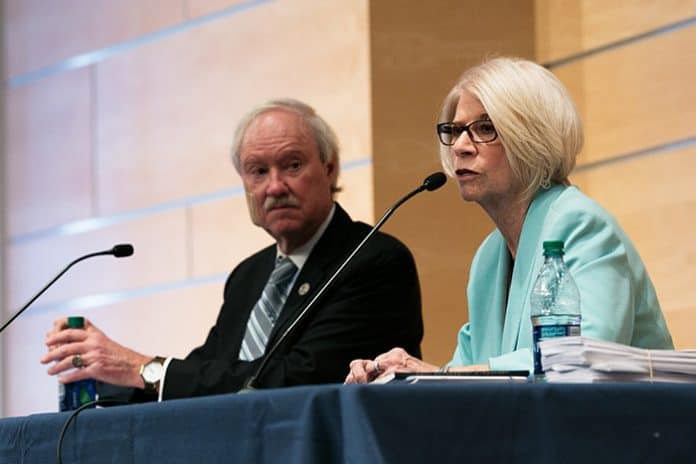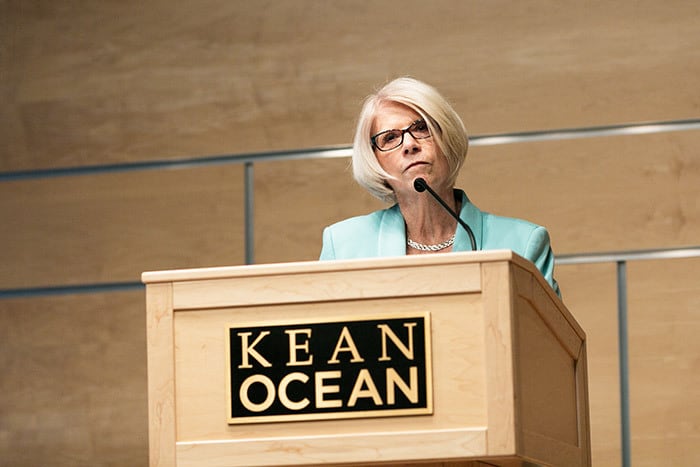
TOMS RIVER – Two county freeholders recently dropped by Ocean County College to give a “state of the county” presentation to students and the public.
Freeholders Virginia Haines, a former chairwoman for the Ocean County College Foundation Board, and John Bartlett, freeholder liaison to OCC, provided comments before fielding questions from audience members. They were introduced by college president Jon H. Larson, PhD.
Haines spoke first, starting her comments with sharing that the Foundation provides $600,000 in scholarships each year to Ocean County residents, enabling them to attend “the number one community college in the state of New Jersey.”
“We are the first in many things. We are the first community college in New Jersey, and to me, we are still and always will be the number one community college,” Haines said.
Haines gave audience members a brief rundown of the mechanics of county government and history, and gave a startling example of the county’s growth: In 1950, the county had 50,000 residents. Today, there are more than 600,000 residents. There are 21 libraries and 27 county parks to serve residents.
“Ocean County is, in a lot of areas – not just with parks and libraries – rated No. 1 in many, many areas,” Haines said.
Even with the vest web of county government – each freeholder has his or her own sphere of responsibility and trusts the others to fill them in as needed – Bartlett quoted Harry S. Truman as saying “the buck stops here [with the freeholders].”
Bartlett started his remarks with a quick history of the establishment of OCC, established on paper in 1964 and a functioning college two years later. He’s a graduate of its first class.

“It’s amazing to me what benefits the associate degree from Ocean County College has meant to me in my life,” Bartlett said. “It’s as if the college has weaved in and out of my life forever. …I’m exceedingly proud to be associated with Ocean County College.”
The freeholders have budgeted $15 million to OCC this year, Bartlett said. The county contributes to the college every year, and never do the freeholders fight about budgeting that money for the college, Bartlett added. The county has sought out partnerships to build OCC into the campus (it now shares with Kean University) that it is today.
Bartlett is also called by his county colleagues “the architect” of the county budget. He touched upon how they build that each year.
“There’s a million things that governments can do that sound great. All you have to do is listen to some campaigns some time…We’re going to have heaven on earth,” politicians will promise. “But guess what? All of those dollars come from the taxpayers. They come out of whose pocket? Yours. So, who can decide better where to spend your money? [You.] Now, not everyone would agree with that, but I certainly do.”
The government has a limited function, and what it does, it will do well. But it can’t do everything, Bartlett added. The county has a AAA bond rating—30 years in the making—and kept it despite losing 20 percent of its ratable income after the great recession and Superstorm Sandy.
FEMA reimbursement
Sometimes being fiscally prudent baffles bureaucrats.
The county spent $100 million of its own money cleaning up after Superstorm Sandy. When it came time to get reimbursement through the Federal Emergency Management Agency, the feds insisted the county got the money from somewhere.
“‘Who advanced you? No one has that kind of money,’” Haines repeated to the audience, a FEMA rep speaking with the county. “Ocean County, we were able to do it. They were fighting with [Ocean County], saying we had to have gotten the money from somewhere.”
The county is the only government entity in the entire country that has been able to finance its own cleanup, she said. The county eventually got its money reimbursed from the federal government.
The county was eligible for an additional $10 million from the state. The county in turn gave the municipalities that joined their post-hurricane clean-up project their 10 percent back that they paid into the cleanup.

Homelessness In Ocean County
Don’t expect the county to build its own homeless shelter, but continue looking for it to provide some financial help to organizations that do help the county’s homeless.
The county works with the boards of social services and human services to provide millions of dollars for the homeless population, Haines said.
She added that many homeless will not live in a shelter, as they are unwilling to abide by shelter rules.
“As much as we’ve tried to get people into facilities, because we do have hotels and motels around Ocean County that are able to provide temporary housing, but some will abide by certain things and others won’t,” Haines said.
Code Blue facilities – those that open to the homeless population when temperatures drop below freezing – are regulated by statutes. Although churches and other organizations would like to help, they can’t receive government funding because their facilities don’t meet those regulations. There were two buildings that opened this winter – one in Lakewood, one in Toms River – and people in the southern part of the county were transported to one of those two places.
Bartlett would like to see more faith-based and private organizations step up if they are so inclined, because a government-run shelter only runs into so much red tape. The county can make contributions to such shelters, which are generally free to operate as they wish.
Business closings in Ocean County
Oyster Creek. Toys R Us. Sears. While the towns that are losing businesses, big businesses, may feel that loss more acutely, those closings are a blip on the county level, Bartlett said.
“The closing of one store, or a couple of stores, in a county this large, really has a negligible effect,” Bartlett said. “Obviously it has a great effect on the poor people who lose their jobs, but as far as the county itself goes, there are ups and downs. Some things move in, some things move out, but on the whole this past year, our ratable base grew by…$2.6 billion.”
Making Ocean County Affordable
“Can I be directly, brutally honest? I don’t think so,” Bartlett said in response to a question about lowering property taxes and the cost of living in Ocean County. “You want the roads to drive on. …Yes, government can spend less. We can take the budget and cut it in half tomorrow. (And one of the first places we’d cut it would be from you guys [OCC students].)”
It comes down to balance, Bartlett said. But is the county willing to spend less on roads? On schools? On services? Probably not.
The Opioid Crisis
Ocean County, while considered “ground zero” in the opioid crisis in the state, is the only county to see a decrease in opioid-related deaths, Haines said. Ocean County Prosecutor Joseph Coronato was the first to equip local police departments with Narcan. He also helped lead the way to a major drug bust recently, which stretched through a half-dozen state counties, up to The Bronx, and overseas.
“He’s doing what he can to fight this epidemic,” Haines said of Coronato.







